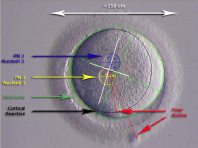|
Introduction: The aim was initiated to assess if morphological characteristics of zygotes could be used as markers of future embryo developmental competence using statistical tools. Thus, allowing us to transfer only the embryos that would result in the highest pregnancy rates while minimizing the high order multiple pregnancies. No study has attempted to evaluate the contribution of morphological characteristics automatically detected by an advanced image analysis tool.

ImageJ Plug-In for automated morphological measurements
Methods: We compare the performance of classification with several statistical methods based on digital images of zygotes at the two pronuclei stage. These methods are linear discriminant analysis (LDA), classification trees (Trees), support vector machine (SVM), and random forest (RF). Methods are applied to two datasets, morphological measurements collected with ImageJ Plug-in (IJPM dataset) and a human expert scoring of the LABR (CHUV - CH) (PNS dataset). We also compare the performance with the conventional LABR classification (CPNS).
|
Results: We found that the RF approach with IJPM dataset leads to an overall lower misclassification rate compared with the developed methods. Improvement is of 6% (CPNS compared to IJPM). This affects to the selection of each zygote, however, the gain in the probability of implantation is larger. Hence, we develop the theory that allows computing the probability of success.

Implantation rate comparison after four transferts
Probability of success after 4 attempts (i.e. 8 zygotes) for CPNS is of 30.8% (CPNS 4), for PNS dataset it is of 58.2% (PNS 4) and for IJPM dataset it is of 65.6% (IJPM 4).
Conclusion: Modern methods, advanced image analysis tools combined to statistical classifiers, allow significant improvement of embryo implantation. Introduction of such procedures into routine clinical practice has the potential to increase patient satisfaction and ultimately to improve outcome.
|